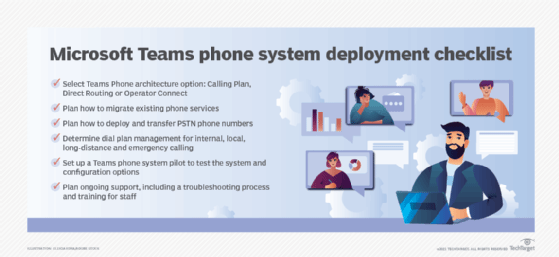
Getty Images/iStockphoto
How to integrate your phone system with Microsoft Teams
Before organizations migrate their existing phone systems into Microsoft Teams, they need to select the right telephony architecture that fits their business needs.
Because of the popularity of Microsoft Teams as a collaboration, messaging and video conferencing tool, many IT leaders are hoping to squeeze a bit more out of the communications platform. One way to do this is to migrate an existing telephony system into Teams using the Teams Phone integration feature.
Let's learn more about Microsoft Teams Phone and walk through a checklist of deployment tasks and options that must be considered before a migration.
What is Microsoft Teams Phone?
Teams is a communications platform that's part of the larger Microsoft 365 portfolio of products, which includes popular applications such as Outlook, Word, PowerPoint and OneDrive. While all Microsoft 365 license plans include basic Teams features, only the E5 plan delivers a phone system. All other plans require an add-on phone license to take advantage of telephony calling.
Teams Phone enables users to make and receive internal calls, as well as local and long-distance calls across the public switched telephone network (PSTN). The service also enables each user to have their own telephone number assigned to them. Thus, instead of managing a separate, on-premises PBX or cloud calling system, such as RingCentral, 8x8 or Dialpad, users can use the same Teams platform they already know and take advantage of an enterprise-grade business phone system.

Selecting a Teams Phone architecture option
Telephony needs vary widely from one business to the next. Because of this, Microsoft provides several Teams Phone deployment options from simple setups to more complex voice systems. IT departments select from one of the following Teams Phone architecture options:
- Fully cloud-managed phone system with built-in Teams calling plan. This is the simplest architecture option as all PBX, call control and PSTN management is handled directly through the Microsoft 365 platform. Different calling plans are available depending on how many long-distance or international minutes the business is likely to use each month.
- Cloud-managed phone system with third-party calling plan. Organizations can use Teams to manage internal voice calling features while connecting to a third-party telephony carrier through Direct Routing. Customers could also use a partner carrier that integrates with Teams using the Operator Connect functionality for PSTN access.
- Mixed-mode phone system. Organizations can use Teams to manage internal voice calling features while using a combination of a Teams calling plan, third-party telephony and/or the ability to use a partner carrier that integrates within Teams using the Operator Connect functionality.
Choosing one of the above architecture options largely depends on the following:
- whether or not the business already uses a third-party telephony carrier and wants to continue using that service;
- geographic location of users and PSTN telephone numbers; and
- whether complex features, such as location-based routing, are required.
Teams Phone migration and management checklist
Once a Teams Phone architecture is selected, voice over IP architects must consider how the following migration and management tasks should be formulated and handled within Teams:
- How to migrate existing phone services to Teams Phone. Depending on the architecture selected, this may or may not include tasks such as PSTN number porting, redeploying physical phones -- if supported -- for Teams voice operation and the configuration of business voice features, such as voicemail, hunt groups, auto attendants and audio conferencing. A migration plan should also detail how users and production devices will be migrated over a specified timetable.
- PSTN number management. This task details how you want to manage the deployment and transfer of PSTN phone numbers -- also known as direct inward dialing numbers. This also depends on the architecture option selected above.
- Dial plan management. These tasks revolve around how internal, local, long-distance and emergency calls will be handled depending on geographic location and PSTN carrier choice.
- Setting up a Teams Phone pilot. Before jumping into Teams Phone, organizations should set up a pilot program. This program should include users who will do the following:
- use voice services in various geographic locations;
- use differing device hardware and software; and
- make internal, local, long-distance and international calls.
- Ongoing support. Finally, IT departments must train operations staff to manage the new voice platform and streamline the troubleshooting process when end users run into problems.








